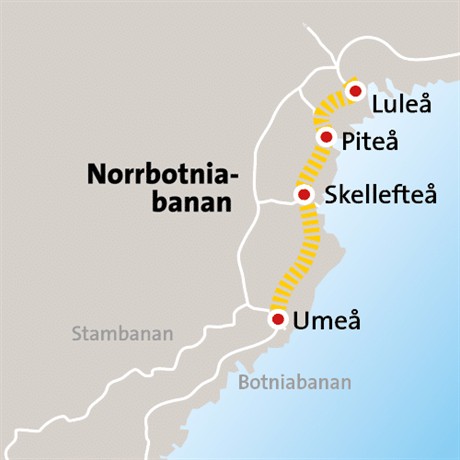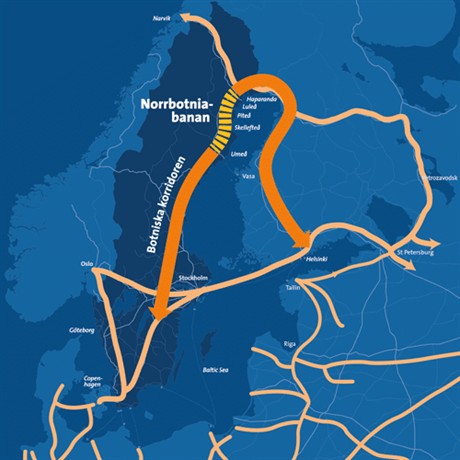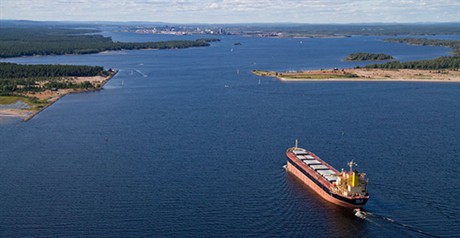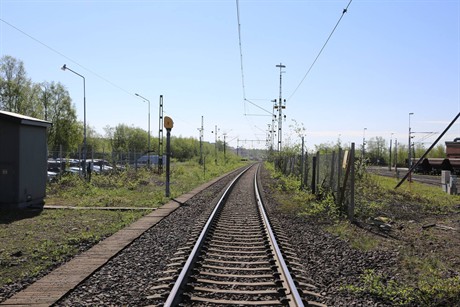National Transport Plan for 2018-2029
On June 4, the Swedish government presented the National Plan for Infrastructure, also known as NTP, for the period 2018-2029. The plan covers a total budget of SEK 700 billion. For Västerbotten and Norrbotten, the two northernmost counties in Sweden, the new plan covers several new railway constructions as well as upgrading and modernization of existing railways, multimodal operations and shipping.
- This is the biggest railway initiative in modern time in Sweden, said Minister for Infrastructure Tomas Eneroth at the press conference when the national plan for infrastructure for the period 2018-2029 was presented on June 4.
The plan covers a total budget of SEK 700 billion. The Infrastructure investments are increased by SEK 100 billion to a total of SEK 622.5 billion. The remaining SEK 90 billion will come from congestion tax, rail charges and co-funding. The budget allocation by measures:
- SEK 333.5 billion for the development of the transport system by
rail, shipping, road and bicycle
- SEK 125 billion for operation and maintenance of state railways
- SEK 164 billion for operation and maintenance of state roads
For Västerbotten and Norrbotten, the new plan includes construction of several new railway sections and upgrading and modernization of existing railways, multimodal operations and shipping.
The government gives in the plan a clear mandate to the Swedish Transport Administration to begin the construction works on the North Bothnia Line (NBB). For the North Bothnia Line the construction works will begin on the section Umeå-Dåva during 2018-2020. The construction on the section (Umeå)Dåva-Skellefteå is scheduled to start 2024-2030.

The government released information about the content of major objects in the National Plan for Infrastructure in stages days before the official publication. On June 1, Infrastructure Minister Tomas Eneroth announced that SEK 7 billion as part of the National Transport Plan (NTP) would be allocated to start the construction works on the North Bothnia Line (NBB).
- We are very happy with today's message. The time of speculation is over, now we know that the government wants to build the North Bothnia Line, and Sweden's significance for Sweden has been reaffirmed. Together we have worked together in the five northernmost regions and with Region Örebro County to describe how the transport system is being developed to take advantage of the benefits we create in the north. Our clear message and the weight we get when we act together in northern Sweden have made it possible for the government to make big investments in our regions, said Erik Bergkvist (S), President at Region Västerbotten.

The government will apply for co-funding from the Connecting Europe Facility CEF for the entire North Bothnia Line including the second phase Skellefteå-Luleå, said Tomas Eneroth, and pointed out that the government has submitted a request to the European Commission to extend the TEN-T Core Network Corridor Scandinavia-Mediterranean (ScanMed), which today only extends to Stockholm, along the coast in northern Sweden and to the Swedish-Norwegian border to Narvik and the Swedish-Finnish border Haparanda-Torneå. On 6 June, the European Commission is expected to publish the draft CEF Regulation for the period 2021-2027, after which the trialogue will begin between the Council, the European Parliament and the European Commission. The European Commission is aiming for the parties to reach an agreement on the CEF Regulation before the European Parliament elections due in May 2019.
- Understanding the significance of the North Bothnia Line is growing. A receipt is that the government has requested the EU to work to extend one of the nine core network corridors, ScanMed. This corridor ends today in Stockholm, but the government has requested it to be extended to Haparanda-Torneå and Narvik. It will positively affect the construction of the North Bothnia Line, said Lorents Burman, Mayor of Skellefteå and Chairman of the Norrbotniabane Group.

The National Transport Plan includes several named measures on the Iron Ore Line (Malmbanan) including railroad extensions and the introduction of the ERTMS signaling system on the Luleå-Riksgränsen (Narvik) railway section. The plan also includes major re-investments on the Iron Ore Line (contact line, tracks), and bridge over the Kalix river.
In addition, the government assigns to the Swedish Transport Administration to carry out a capactiy analysis on the railway section Narvik-Luleå, and to analyze future function on the inland railway section (transfer of road to rail and diversion) and Upper (Övre) Norrland Skellefteå / Bastuträsk-Boden / Luleå, and the lack of capacity on the railway system. On shipping, the state will cooperate with Luleå municipality and LKAB in the Malmporten project to contribute to increased capacity in the Port of Luleå through dredging operations of the waterways. In addition to what the Swedish Transport Administration has proposed at national level, further measures are also included on the E10 in the County of Norrbotten to ensure high traffic safety, usability and accessibility for road users, as well as the ability to maintain the current speed limit of 100 km/h. Measures are also planned for the E12 and E4 in the County of Västerbotten.

Tomas Enertoh also said that the Swedish government intends to initiate a dialogue with the Norwegian government to accelerate the development of important cross-border railway sections with a strong market interest on the Iron Ore Line (SE)/Ofotbanan (NO) and on the sections Stockholm-Oslo and Gothenburg-Oslo. Tomas Eneroth pointed out that an extension of the TEN-T Core Network Corridor the Scandinavian-Mediterranean, which he has proposed to the European Commission, opens up to co-funding from the CEF thus facilitating investments on important infrastructure also along the border with Norway.
- The County of Norrbotten has not been given such a strong priority in the National Infrastructure Plan for a long time and it is extremely gratifying that many important investments and reinvestments are being made to strengthen the Arctic region of Europe. The current government has been responsive to the votes of our regions, said Maria Stenberg, Chairman of the regional board, Region Norrbotten.
Funds from the National Transport Plan will be allocated to the Regional County Transport Plans. During the period 2019-2022, the Swedish Transport Administration will allocate up to SEK 1 billion to co-finance regional county tranpsort plans for measures in the regional road network. The government has set the definitive financial framework for regional transport infrastructure in Norrbotten to SEK 812 million and in Västerbotten County to SEK 919 million. The counties are in charge to prioritize allocation of these funds in each County Transport Plan. By October 1, 2018, the planning authorities in the counties will set the respective county plan.
The National Infrastructure Plan includes furthermore horizontal initiatives such as the City Environment Agreement thus providing funding for municipal and regional investments in infrastructure for bicycle and public transport. The government extends these funds to SEK 1 billion per year, thus allocating a total of SEK 12 billion during the plan period.
The budget for research and innovation is increased to SEK 8 billion as to increase the rate of innovation, where shipping is pointed out as a particularly important area, and to accelerate the implementation and commercialization of research results.
Faktablad: Nationell infrastruktur för framtiden – bygger Sverige starkt och hållbart för framtiden (Swedish)
Regeringens infrastruktursatsningar – så bygger vi norra Sverige starkt och hållbart (Swedish)
Bilaga 1: Större investeringar över 100 miljoner kronor i nationell infrastruktur (Swedish)
Bilaga 2: Utpekade bristanalyser (Swedish)
/Mona Mansour
